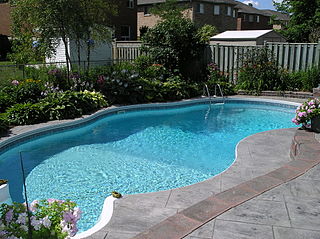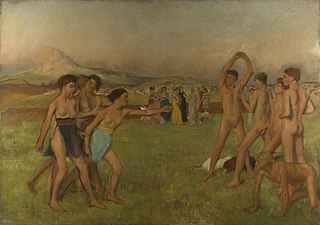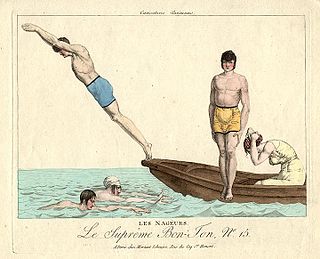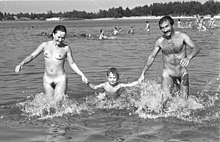
Naturism is a lifestyle of practicing non-sexual social nudity in private and in public; the word also refers to the cultural movement which advocates and defends that lifestyle. Both may alternatively be called nudism. Though the two terms are broadly interchangeable, nudism emphasizes the practice of nudity, whilst naturism highlights an attitude favoring harmony with nature and respect for the environment, into which that practice is integrated. That said, naturists come from a range of philosophical and cultural backgrounds; there is no single naturist ideology.

A swimsuit is an item of clothing designed to be worn by people engaging in a water-based activity or water sports, such as swimming, diving and surfing, or sun-orientated activities, such as sun bathing. Different types may be worn by men, women, and children. A swimsuit can be described by various names, some of which are used only in particular locations or for particular types of suit, including swimwear, bathing suit, bathing attire, swimming costume, bathing costume, swimming suit, swimmers, swimming togs, bathers, cossie, or swimming trunks, besides others.

The bathing machine was a device, popular from the 18th century until the early 20th century, to allow people at beaches to change out of their usual clothes, change into swimwear, and wade in the ocean. Bathing machines were roofed and walled wooden carts that rolled into the sea. Some had solid wooden walls, others canvas walls over a wooden frame, and commonly walls at the sides and curtained doors at each end.

Bathing is the act of washing the body, usually with water, or the immersion of the body in water. It may be for personal hygiene, religious ritual or therapeutic purposes. By analogy, especially as a recreational activity, the term is also applied to sun bathing and sea bathing.

Toplessness refers to the state in which a woman's breasts, including her areolas and nipples, are exposed, especially in a public place or in a visual medium. The male equivalent is known as barechestedness.
In film, nudity may be either graphic or suggestive, such as when a person appears to be naked but is covered by a sheet. Since the birth of film, depictions of any form of sexuality have been controversial, and in the case of most nude scenes, had to be justified as part of the story.

Sea bathing is swimming in the sea or in sea water and a sea bath is a protective enclosure for sea bathing. Unlike bathing in a swimming pool, which is generally done for pleasure or exercise purposes, sea bathing was once thought to have curative or therapeutic value. It arose from the medieval practice of visiting spas for the beneficial effects of the waters. The practice of sea bathing dates back to the 17th century but became popular in the late 18th century. The development of the first swimsuits dates from the period as does the development of the bathing machine.

Nude recreation consists of recreational activities which some people engage in while nude. Historically, the ancient Olympic Games were nude events. There remain some societies in Africa, Oceania, and South America that continue to engage in everyday public activities—including sports—without clothes, while in most of the world nude activities take place in either private spaces or separate clothing optional areas in public spaces. Occasional events, such as nude bike rides, may occur in public areas where nudity is not otherwise allowed.

The history of nudity involves social attitudes to nakedness of the human body in different cultures in history. The use of clothing to cover the body is one of the changes that mark the end of the Neolithic, and the beginning of civilizations. Nudity has traditionally been the social norm for both men and women in hunter-gatherer cultures in warm climates, and it is still common among many indigenous peoples. The need to cover the body is associated with human migration out of the tropics into climates where clothes were needed as protection from sun, heat, and dust in the Middle East; or from cold and rain in Europe and Asia. The first use of animal skins and cloth may have been as adornment, along with body modification, body painting, and jewelry, invented first for other purposes, such as magic, decoration, cult, or prestige. The skills used in their making were later found to be practical as well.

Nudity is the state of being in which a human is without clothing. While estimates vary, for the first 90,000 years of pre-history, anatomically modern humans were naked, having lost their body hair and living in hospitable climates. As humans became behaviorally modern, body adornments such as jewelry, tattoos, body paint and scarification became part of non-verbal communications, indicating a person's social and individual characteristics. Indigenous peoples in warm climates used clothing for decorative, symbolic or ceremonial purposes but were often nude, having neither the need to protect the body from the elements nor any conception of nakedness being shameful. In many societies, both ancient and contemporary, children might be naked until the beginning of puberty. Women may not cover their breasts, being associated with nursing babies more than with sexuality.

A swimming pool, swimming bath, wading pool, paddling pool, or simply pool, is a structure designed to hold water to enable swimming or other leisure activities. Pools can be built into the ground or built above ground, and may be found as a feature aboard ocean-liners and cruise ships. In-ground pools are most commonly constructed from materials such as concrete, natural stone, metal, plastic, composite or fiberglass, and can be of a custom size and shape or built to a standardized size, the largest of which is the Olympic-size swimming pool.

The Swimming Hole is an 1884–85 painting by the American artist Thomas Eakins (1844–1916), Goodrich catalog #190, in the collection of the Amon Carter Museum of American Art in Fort Worth, Texas. Executed in oil on canvas, it depicts six men swimming naked in a lake, and is considered a masterpiece of American painting. According to art historian Doreen Bolger it is "perhaps Eakins' most accomplished rendition of the nude figure", and has been called "the most finely designed of all his outdoor pictures". Since the Renaissance, the human body has been considered both the basis of artists' training and the most challenging subject to depict in art, and the nude was the centerpiece of Eakins' teaching program at the Pennsylvania Academy of the Fine Arts. For Eakins, this picture was an opportunity to display his mastery of the human form.

This timeline of social nudity shows the varying degrees of acceptance given to the naked human body by diverse cultures throughout history. The events listed here demonstrate how various societies have shifted between strict and lax clothing standards, how nudity has played a part in social movements and protest, and how the nude human body is accepted in the public sphere.
Bara Bröst network is a cultural movement of Swedish feminists campaigning for the right of women to swim topless and to bare their breasts at beaches and in public pools.

Mixed bathing is the sharing of a pool, beach or other place by swimmers of both genders. Mixed bathing usually refers to swimming or other water-based recreational activities in public or semi-public facilities, such as hotel or holiday resort pool, in a non-sex segregated environment.

Robby is a 1968 family film written and directed by Ralph C. Bluemke. It is a modern-day retelling of Daniel Defoe's 1719 novel Robinson Crusoe in which the main characters are portrayed as children. The film deals with many themes, including friendship, homesickness, racial blindness and naturism.

The history of swimwear traces the changes in the styles of men's and women's swimwear over time and between cultures, and touches on the social, religious and legal attitudes to swimming and swimwear.

Nude swimming in US indoor pools was common for men and boys from the late 1880s until the early 1970s, but rare for women and girls. For much of that time period, indoor pool use was primarily for physical education or athletic competition, not recreation. Male nude swimming had been customary in natural bodies of water, which was not viewed as a social problem until the 18th century. When the tradition of skinny-dipping in secluded spots had become more visible with urbanization, indoor pools were first built in the 19th century in part to address this issue by moving male swimming indoors. For the first decades of the 20th century, male nude swimming was associated with a trope of the "old swimming hole" as representing childhood innocence and adult masculinity. In their own classes, nudity was rare for girls based upon an assumption of modesty, but might include young children. Prepubescent boys might be nude in mixed-gender settings, including the presence of female staff, public competitions, and open houses for families.

In contemporary societies, the appropriateness of childhood nudity in various social situations is controversial, with many differences in behavior worldwide. Depending upon conceptions of childhood innocence and sexuality in general, societies may regard social nudity before puberty as normal, as acceptable within same-sex groups, or unacceptable.


































